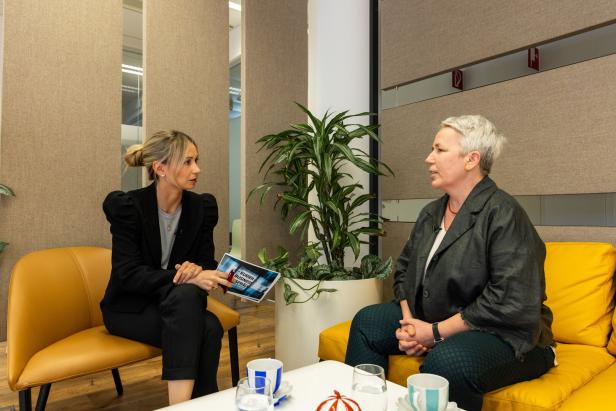Monika Haselbacher is the first Chief Operating Officer at the Viennese high-tech company Frequentis. In 2023 she took up the newly installed position on the board. Your clear mission is to drive forward new projects. It reveals what customers are demanding today and why drones will soon dominate the airspace.
COURIER: Would you briefly outline the fields in which Frequentis is active?
Monika Haselbacher: We are there wherever safety-critical infrastructure is required, especially in control centers. Because there are people there who help other people, for example by directing traffic or saving lives. And we provide the technology for this – it can look very different.
You have been with Frequentis since 1998 – how much progress has happened in almost three decades?
Of course we have grown incredibly. We were around 300 employees, now we are 2,200 with over 40 locations worldwide. We have developed additional business areas from the nucleus of air traffic control, in police, rescue and fire services, in the public transport network or in maritime systems as well as in the defense sector.
Monika Haselbacher was a guest in the KURIER Business Talk, which can also be seen on KURIER TV on May 4th at 7 p.m
The current annual report shows encouraging figures: a record number of incoming orders and a significant increase in sales and profits were achieved. What is this due to?
We are constantly expanding our product portfolio, but many customers have also been very cautious about investments in recent years since the Corona pandemic. Our sales cycles don’t just last a few months. We have been working with customers for several years and have had success. We have won very large contracts, including the French railway SNCF, in Norway there was a large contract for healthcare organizations and in the USA we also won network contracts.
Frequentis has customers in 150 countries – in Austria you work with Austro Control, ÖBB and Wiener Linien, among others. What technologies are you providing?
For example, we started a pilot operation with ÖBB in which drones inspect the routes. Until now, people actually had to walk along the routes themselves. To make this more efficient, drones are now doing this with their cameras. But this is just one project of many.
Business conversation: Monika Haselbacher
Drones seem to be a very present topic. You also place a strong focus on this in your research. For what reason?
There’s a headline going around: In 15 years there will be more drones than planes in the air. This means that the issue of security is very important. You have to prevent anything from colliding or causing an accident, that’s the area in which we operate. There are also areas of application for drones for all of our customers. Let’s think of the fire department – if a situation is too dangerous for people, you can send drones with their cameras and inspect the surroundings.
Have customer needs become more complex?
Because we have expanded our product portfolio so much, they are much more versatile. Regulations make things more complex.
Does this mean that the technology your customers need usually already exists or does it need to be developed?
We always consider where there are new topics that may not have reached customers yet. But customers are very different – there are very innovative ones who think a lot and there are those who would rather use something that someone else has already tried.
Which are the most advanced?
German air traffic control, for example, or ÖBB and Austro Control. The Nordic countries are also very ahead in terms of innovation.
Frequentis was founded in 1947, during the reconstruction period. Today we need more security and communication solutions than ever before. Is now the company’s high point?
You don’t know what’s coming next (laughs)! But sure, there are so many interesting topics, for example automation. Communication will perhaps take place less from person to person than from machine to machine. We want to be there everywhere.
How much do you work with artificial intelligence or is it already old hat?
I wouldn’t say it’s old hat. It’s a new hat that we’re definitely putting on our heads. It is already used in products and we are also checking it in internal processes. We are not yet that far into production. We always have to be careful because we are in a safety-critical area. What we do has to really work.
So, so far you only trust people 100 percent.
Correct.






